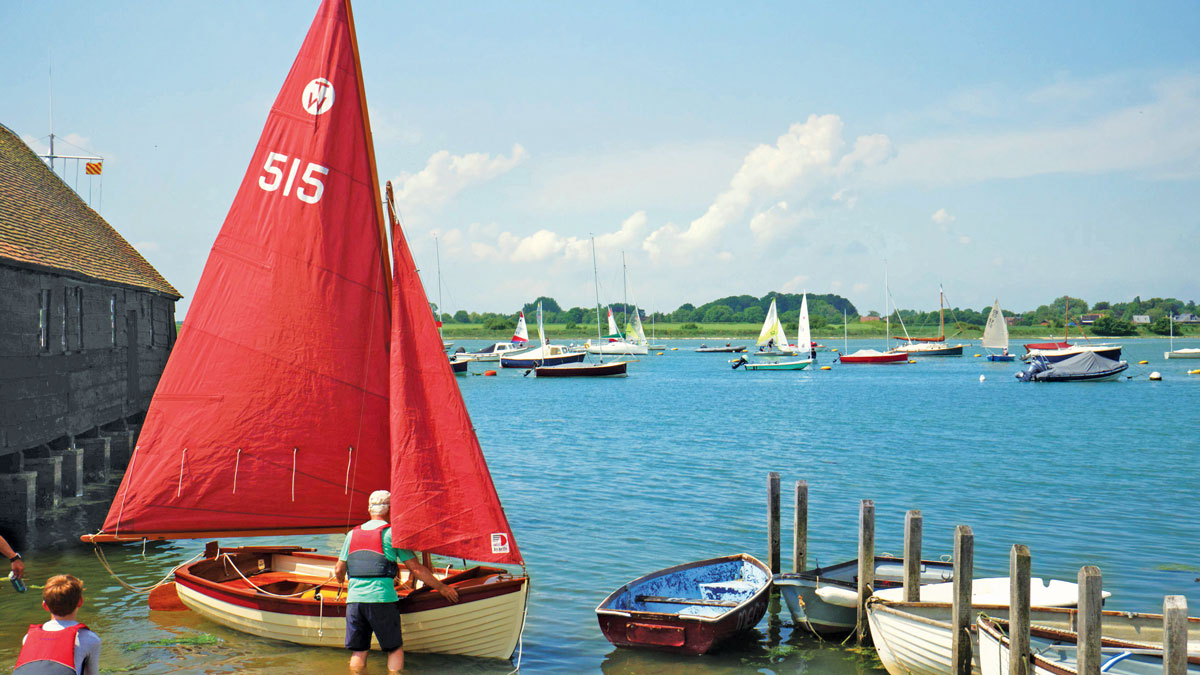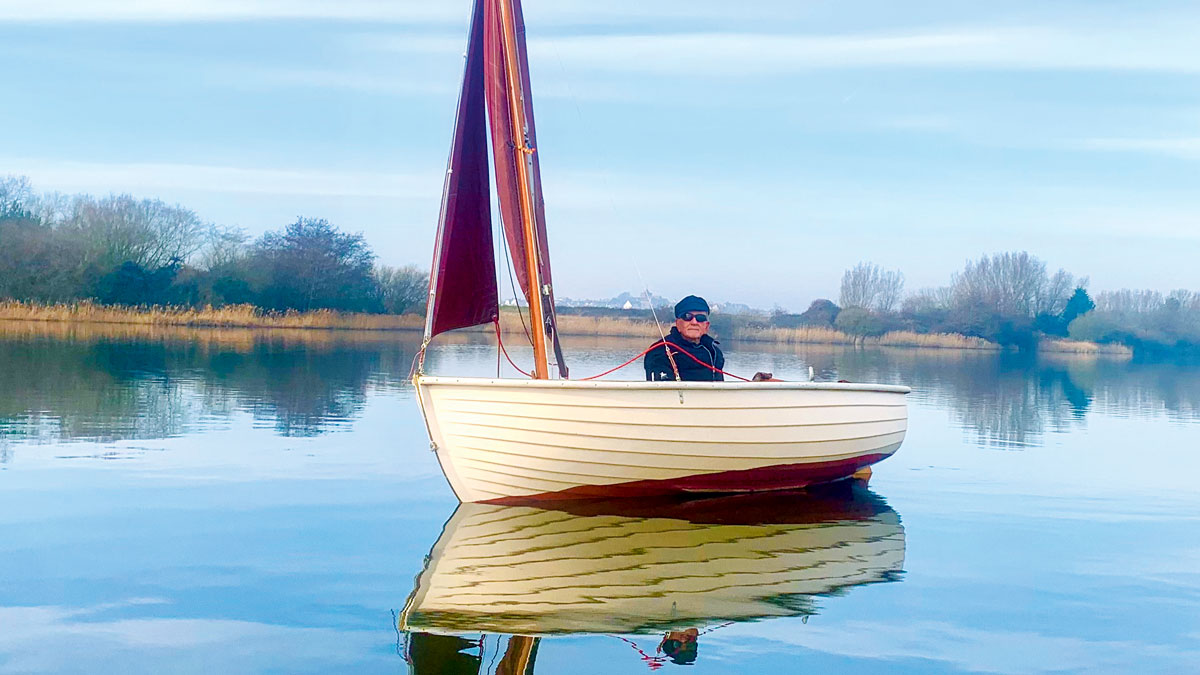Simple lug rigs for ease of-handling make these ‘popular tenders for discerning sailors’ Clive’s choice for single-handed dinghy cruising
Allan Earl, the author of the marvellous book Dinghy Cruising, published in 1945 successfully sailed his 10ft clinker dinghy all along the Dorset, Hampshire and Sussex coast.
And as the knowledgeable Allan said: ‘A light man or woman should not have a large boat as the seaworthiness of a dinghy depends largely on the way the crew sit her up, and he/she will not have the weight to keep a large boat under full control unless she is under-canvassed. It is also probable that he/she will not have the strength to pull her up a rough beach’.
So let’s look at the smallest of cruising dinghies, the Emsworth Lugger.
The Emsworth Lugger, once built by Dorado Boats of Emsworth, is a traditional lug sail dinghy much favoured by discerning yachting folk as a sailing tender.
They are useful little working boats and the simple lug rig with no stays makes for ease of handling and sailing.
The GRP simulated clinker hull with wine glass transom and skeg is attractive to those who appreciate the lines of classic boats.
They are often seen hanging from the stern davits of traditional yachts.
But for me, the Emsworth Lugger is an excellent little sailboat for single-handed dinghy cruising.

The Emsworth Lugger is possible to launch and recover single-handed, without a vehicle
The Dinghy Cruising Association has thousands of members throughout the world and I’ve noticed that older members like me tend to favour lighter boats – we’ve learned that hauling heavy boats up a slipway is not good for your health.
Also, as we get older and our young crews are getting on with their lives we increasingly sail alone.
I do keep a bigger boat for when I have company, but the Emsworth Lugger is more fun when sailed solo.
It is easily launched and recovered single-handed without the need for a tractor or a car. It can also be beach-launched.
Being under 10ft, the position of the helm and crew in this dinghy has a noticeable effect on performance.
Lighter helms might simply lean back on the aft bulkhead while seated on the cockpit sole.
However, it’s best to keep the boat properly trimmed by careful positioning of the crew and any heavy equipment.
In stronger winds, the helm or crew can provide ballast by sitting to windward.
The Emsworth Lugger is comfortable and predictable to sail and can carry a reasonable amount of ‘stuff’ when in use as a tender under oar or motor.
It’s comfortably sailed with the addition of a small child up forward to help with the trim.
Grandchildren are ideal but they grow up fast and before long will need a bigger boat.
If sailed with a crew there is no kicking strap to get in their way and the boom gives better-than-average head clearance for the helm.
Launching from the beach is always a challenge even with the slightest of surf.
For a few years, I kept the lugger at the Hastings & St Leonards Sailing Club where most members sailed Lasers, Toppers and other self-draining types of craft that are ideal for launching through the surf.
Pushing the lugger through the surf and clambering aboard while avoiding a broach took some practice and concentration but once out at sea, she coped better with the chop than the more extreme dinghies.
Of course, she wouldn’t win any races around the buoys but for cruising along the coast she was a good reassuring sea boat.
Hastings beach is all pebbles, so I tend to just slide the boat in and out of the sea sometimes putting gas pipes under the shallow keel to avoid the hull sticking into the stones.

Ready to drop anchor for lunch and a kip
One advantage of the Emsworth Lugger is her lack of a centreplate where beach stones can frequently get stuck up the casing.
She just uses a daggerboard and any stones can easily be shaken out and the board raised.
I found that using the trolley was more bother than it was worth since the wheels dug into the shingle.
I used a winch or block and tackle secured to a convenient post to drag her up the steep beach.
Once on the flat, it was just a case of lifting the bow and kicking the trolley beneath the hull.
Chichester Harbour is a great place to sail the Emsworth Lugger and visit the villages and pubs at Bosham, Itchenor, Dell Quay and Emsworth.
My preferred place to launch is Itchenor Hard which has a car park close by. Bosham is similar with both a hard and a slipway. Cobnor is very well located but is only available by private arrangement.
Other slipways I have used include Rye Harbour which has two slipways, Warsash, the Beaulieu River, Martham in Norfolk and the Percuil at Falmouth.
Of course, there are many more but these are my favoured ones in the south.
Most slipways require a fee to be paid to the harbour authority or the owner.
Although the Emsworth Lugger is solidly built she is small and light so hauling up a slipway on a trolley by hand may be possible for most people.
However, to make things easier I often empty the boat of all rig, mast, spars, board, rudder, equipment and my lunch in order to make hauling up much easier.
It also gives me the opportunity to tidy and stow things neatly for next time.
Rigging can be done in just a few minutes. It’s the easiest boat to rig that I own.
Simply drop the mast with the halyard attached into the slot aft of the forward bulkhead. Attach the halyard to the yard and haul up.
I leave the sail laced onto the yard and the boom. A short piece of rope attached to the boom takes a turn around the mast and is cleated to the mast close to the thwart.
A mast hoop or short piece of rope will keep the yard close to the mast. Adjust to get the perfect sail shape.
This is one boat where I have rarely needed to use auxiliary power.
She is such an easy boat to sail, and easy to row in a straight line against a little tide and wind.
A 2hp outboard motor is more than adequate and can be stowed forward when not in use to keep the boat trimmed.
Emsworth Luggers come on the market each year.
A similar boat is the Fareham Lugger which has a racing fleet at the Fareham Sailing and Motor Boat Club.
Two other boats to consider are the Roach Dinghy sold by Anglia Yacht Brokerage and the Tideway 10 lugsail version.
Another boat with similar lines that I like a lot and have owned several of is the Smack’s Boat, but these are longer and a lot heavier.
Tideway 12: seaworthy and stable
Prolific boat owner Clive Marsh extols the virtues of the Tideway 12, which can be launched by hand from a
Tideway 10: Gunter or Lugger?
The trailerable Tideway 10 has the benefits of her sister vessel, the Tideway 12, but is lighter and easier to…
Cruising dinghies for timeless adventures
Trailer-sailers can be stored at home, may not need a motor and can provide cosy accommodation with clever use of…
Drascombe & Devon Lugger vs the Dabber
Designed for safe family boating under sail, or or power, but taken long distance by intrepid sailors, Clive Marsh looks…
Want to read more articles about boats like Emsworth lugger: the easy to handle dinghy?

A subscription to Practical Boat Owner magazine costs around 40% less than the cover price.
Print and digital editions are available through Magazines Direct – where you can also find the latest deals.
PBO is packed with information to help you get the most from boat ownership – whether sail or power.
-
-
-
- Take your DIY skills to the next level with trusted advice on boat maintenance and repairs
- Impartial in-depth gear reviews
- Practical cruising tips for making the most of your time afloat
-
-
Follow us on Facebook, Instagram, TikTok and Twitter








